Liz Collins takes some of her artwork off the wall of her studio at Provincetown’s Fine Arts Work Center. She lays it on the scuffed-up cement floor. The works are on paper, small and unframed. They’re thick with color. One piece — in pink, blue, and black — is a grid that seems to open 12 square holes in the floor. Collins nudges it along the ground, marking the back of the piece with debris.
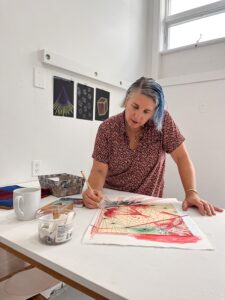
The pieces belong to her new show, now on display at the Commons in Provincetown through Sunday, Sept. 15. “I’m calling it ‘Quick & Dirty,’ ” says Collins. It’s a collection of new prints and paintings she produced at the Fowler dune shack and in her studio at FAWC.
In her more formal exhibitions at museums and galleries, Collins often shows work that reflects the intensity of the labor required to create it. Framed, the art, purposefully or not, commands respect.
For “Quick & Dirty,” though, Collins sought something different: “I don’t want to show any work that’s labored over,” she says. “I like the idea of having a fun, playful, light, accessible, unpredictable body of work in that room.”
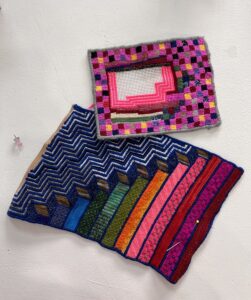
None of the paper pieces will be framed. “It’s an invitation to experience the materiality, the immediacy, of it,” she says. “It’s not trapped behind glass. There’s an intimacy to it.”
Collins isn’t sure how she will hang the works, but she’s sure she won’t be fussy about it — maybe clips, tacks, or magnets. She takes another piece from the wall. This one is textile, a medium Collins works in frequently. It’s thickly embroidered. Yarn in electric shades of pink, blue, green, and orange form a dizzying image of a staircase or stacked blocks.
She bends the piece in half. When she lets it go, it looks slightly misshapen by her handling. She lays this one, too, on the floor. She then stands over the pile, examining her arrangement. It’s not quite right — time to try something else.
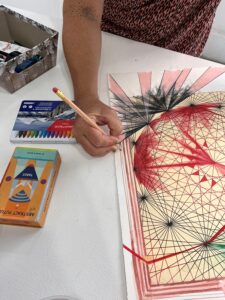
Collins is in the process of reimagining a piece she made recently for a show in New York. In it, a lightning bolt seems to stitch together the two sides of the work: an orderly, checkered image and a shiny field of silver. It’s startling, like a glitch. The piece is patchworked and delicately embroidered.
“I’m going to make screen prints of the image, in experimental one-offs and repetitions,” she says. The result will lack physical texture but won’t be entirely flat. The zones will respond to each other, their colors and visible textures interacting in a defiantly harmonious cacophony.
In the past, Collins has used both paint and textiles in the same work. “The yarn represents the shifting of one state of being to another,” she says. “Suddenly the work appears to liquefy.” The German visual artist Anni Albers called fabric “the pliable plane.” That unlikely movement in art, that formal mutation, is what fascinates Collins.
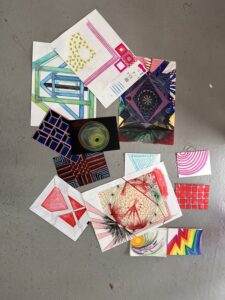
On the wall is a painting on paper, larger than the rest, and still a work in progress. “It’s a print design for a square silk scarf,” says Collins. When it becomes a scarf, it will take on new meaning. “People are going to wear it,” she says. “It’s going to be folded. I’m not thinking of it as a flat artwork. I’m thinking of the way it’s going to transform when it’s a malleable textile draped on someone’s neck.”
Also on the wall are three prints on paper in which hundreds of stark lines intersect, meeting in pinpricks of galactic luminescence and traveling outward again. The lines are straight as stretched yarn, but in the chaos of their mingling, they form shapes that look like circles — even spheres.
They’re recreations of a graphic system that Collins saw in an antique atlas of the sea.
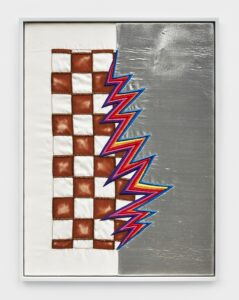
“One of my points of entry to the project was to respond to these navigational systems that it turned out were also decorative,” she says. The distances recorded were somewhat speculative. The lines were clear but artful.
She’s been in dialogue with the works for years now, she says — that sort of relationship with her art is common for her. “I’m not the kind of artist who’s like, ‘OK, now I’m done with that,’ ” she says. For “Quick & Dirty,” she’s considering including two pieces that involve those navigational etchings — this time brought alive by bleeding color.
“I’m finding my way through different techniques, different kinds of strategies,” Collins says. “And, frankly, some of my wayfinding is tied to survival.” Part of the idea behind “Quick & Dirty” is to create affordable art that people will buy. “Ideally I can cover the cost of me being here,” she says.
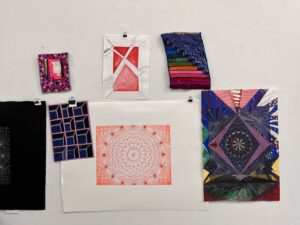
“I’m very scrappy,” says Collins. She taught a class at the Fine Arts Work Center in early August called Trash Lab/Trash Textiles. “If you show up in a studio with nothing except for some paper and basic materials, and you have a week,” she says, “what can you do?”
She’s interested in Arte Povera, the radical Italian art movement in the ’60s and ’70s during which artists made art out of materials like rags and twigs; they turned straw into gold.
“Most artists and designers who are tapped into their creative imaginations,” says Collins, “can make something out of a paper bag.”
Casual Viewing
The event: Liz Collins’s new show, “Quick & Dirty”
The time: Through Sunday, Sept. 15
The place: The Commons, 46 Bradford St., Provincetown
The cost: Free



